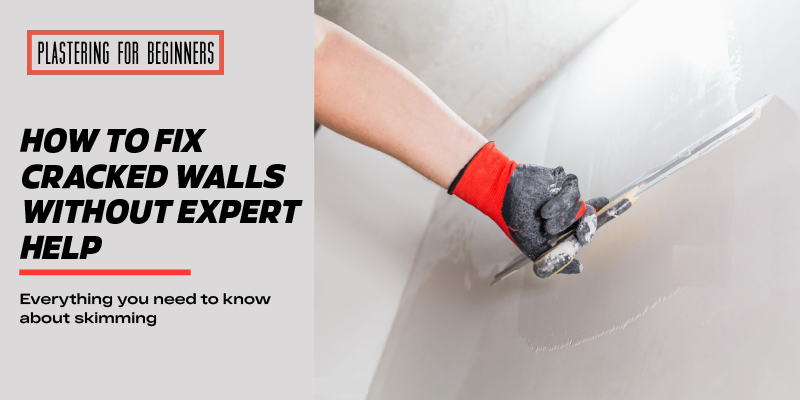
Over the years, the surface of the walls in your home can start to crack. This might happen primarily due to uneven floors, moisture, poor construction, plumber leaks, structural faults, etc. However, you should take immediate care of it because even the tiniest crack can worsen over time to the point of complete renovation. This makes it more challenging for you to fix the walls without overspending. However, these could be avoided if you know how to skim a wall. Skimming the wall will instantly restore the minor crack with the help and prevent it from massively deteriorating the overall wall quality.
If you do not know how to skim a wall, then do not worry. At Plastering For Beginners, we will teach you how to fix your wall without emptying your pockets.
What is Wall Skimming And How Can It Fix The Walls?
Simply put, applying a layer of material to smoothen and fill the cracks in your walls or ceiling is known as wall skimming. This technique’s primary function is to fix uneven wall surfaces, leaving a clean and attractive outcome. The following are the reasons why you should learn how to skim walls:
- Waterproof: Wall skimming allows you to add a layer or seal to the crack, increasing the wall’s moisture resistance. This means skimming the kitchen, bathroom, and ceiling walls will save them from further damage caused by water.
- Repairing imperfections : You can quickly repair wall imperfections with a skim coat by filling the damaged holes, blending the uneven surfaces, and covering the unpleasing patches in the wall. This helps you restore the appearance of the wall, making it all brand-new.
- Decorative surface: Wall skimming allows you to enhance the quality of the wall by adding layers and designed wallpapers. This will enable you to decorate a plain surface using textures and patterns on the walls or ceiling. (Also read from our previous blogs on Overboard Ceilings The Easy Way)
- Cost-effective: Unlike other methods, wall skimming is cost-effective and long-lasting. The best part is that you can always change the texture based on your requirements without increasing your budget.
- Easy to maintain: Typically, Skim coating for wall repairs is cheaper and easy to maintain. The skim coat is less prone to getting dirty, and a quick wipe-down with a sponge will clean the surface quickly.
- Sound-proof: Many people do not know this, but a wall skim coating is also soundproof. The skim layer eventually reduces sound transmission, increasing the acoustic insulation. This helps you to control natural noise in residential buildings.
Types of Wall Skimming Materials
You can choose different skim coats for wall cracks based on your requirements. Some of the popular types are the following:
- Cement-based
Consider the cement-based wall skim if you want a long-lasting and versatile coat for interiors and exteriors.
- Acrylic-based
If you want glossy wall skimming, an acrylic-based skim application will be your best choice. It is 100% weather-resistant and long-lasting. Plus, it is easier to take care of and water-resistant, promising smooth cracked walls in your residential and commercial buildings.
- Gypsum-based
If you need a wall skim specifically for your interiors, you can try a gypsum-based wall skim. This skimming material is the best option when your sole concern is fixing dents or other imperfections. Plus, if you want to furnish the background for wallpaper, a gypsum-based application will be the perfect choice.
How to Skim a Wall Like A Pro
Skimming a wall is easy and would not require expert help if you follow the simple steps. If you want to know how to skim a wall for a beginner, all you need to do is:
- Gather all the materials
Before you kickstart wall skimming, ensure you have all the materials for a smooth execution. Some of the primary materials are a bucket, drywall knife, sanding block, mud pan, and joint compound.
- Prepare the wall
Begin by cleaning the wall you want to skim. Use wet wipes and wait until the wall is completely dry. - Add water to the joint compound.
It is vital to thin the joint compound before skimming the wall. Add an efficient amount of water for a thin and smooth consistency. Once you have done this, you are ready to go.
- Repair the crack
Now, apply the compound to instantly repair cracked drywall. Dip the trowel in the bucket and spread it over the crack. Make sure you use multiple thin layers for a smooth wall.
- Use the sand block
Once you have applied the product to the cracks, use a sand block to evenly smooth any bumps. Repeat the process until you get a smooth finish.
Bottom Line
A small crack in the wall can lead to a bigger one, making it hard to fix without emptying your pockets. This is why you should learn how to skim a wall without any expert supervision. Doing so will not only upgrade your daily life skills but also help you to maintain your home. So, Plastering For Beginners lets you learn how to DIY basic home renovations.
You can connect with us here for more DIY instructions on skimming a wall.
FAQs
1. Is plastering and skimming your wall the same thing?
Not really. Skimming enhances the durability of your walls, while plastering is the very early stage of building a wall, which is finally layered with wall skims.
2. Is skimming safe or unprofessional?
Skimming is easy if you apply the methods correctly. However, it is advised to practise before actually skimming your walls.
